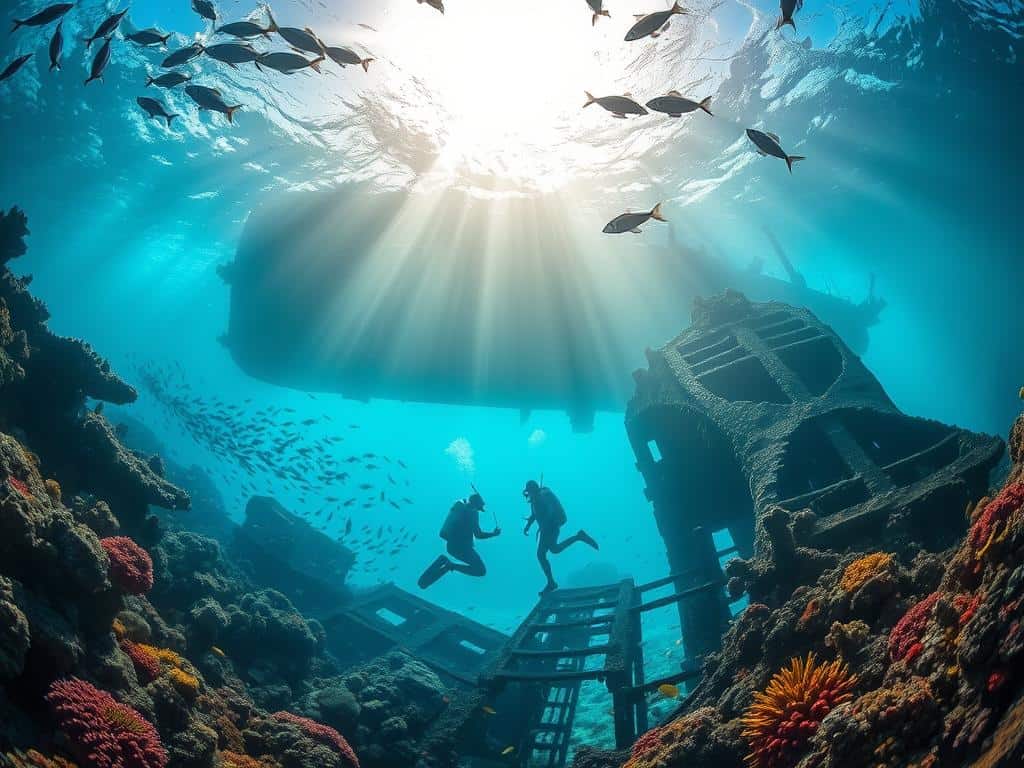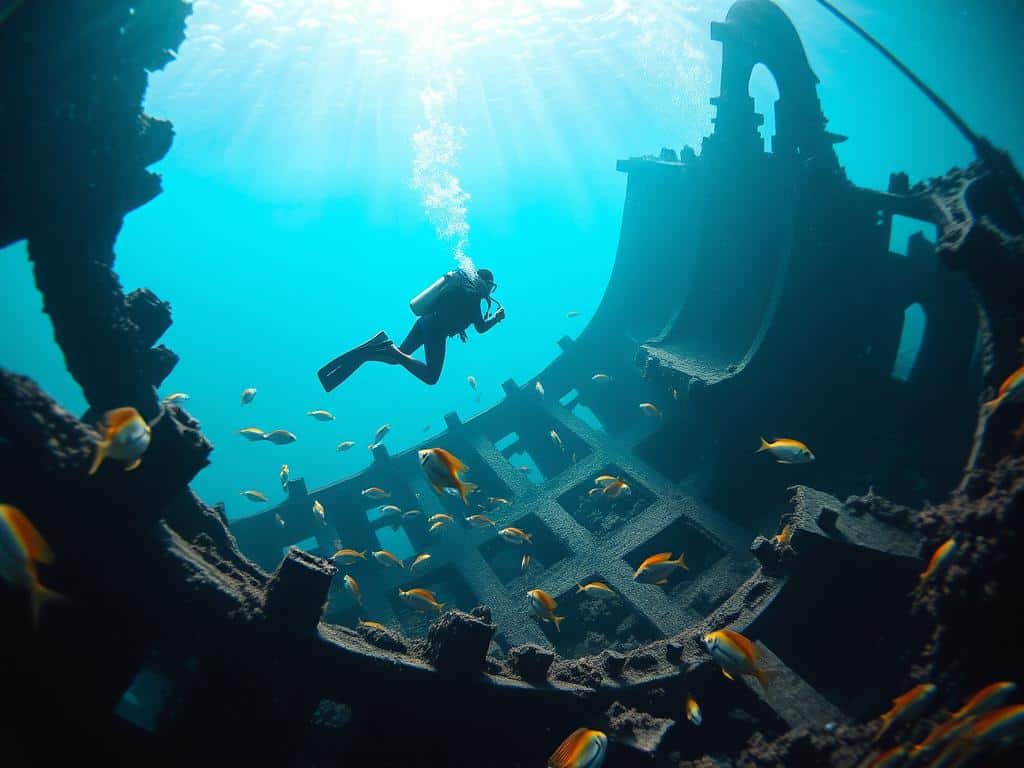Did you know over 300 shipwrecks are scattered around Bermuda’s shores? It’s the wreck capital of the Atlantic. Each wreck is a lost history and an underwater ruin full of stories.
Shipwrecks are a big deal in deep-sea exploration. Divers go there for adventure and to connect with the past. Places like Truk Lagoon and Scapa Flow offer unique experiences. This article will explore the best shipwreck diving spots around the world.
Exploring these underwater sites is more than just a dive. It’s about seeing our maritime history in a new way. Join me as we dive into the mysteries beneath the waves.
Key Takeaways
- Bermuda has over 300 shipwrecks, making it the wreck capital of the Atlantic.
- Scapa Flow features over 70 warships sunk during World War I.
- Truk Lagoon is home to more than 60 Japanese warships wrecked in 1944.
- Shipwreck diving combines adventure with a unique glimpse into lost history.
- Each dive site has its own set of stories waiting to be discovered.
- Diving at these sites can offer revenue benefits to local economies.
Introduction to Shipwreck Diving
Shipwreck diving offers amazing underwater adventures that mix excitement with history. These sunken ships share stories of old travels and dangers. They draw divers with their detailed designs and the marine life they support.
This mix of exploration and learning makes diving into shipwrecks very interesting. It attracts both fans and researchers.
What Makes Shipwrecks Fascinating?
Shipwrecks act as underwater museums, keeping human history alive. They also become artificial reefs, helping marine life thrive. This creates a rich underwater world that divers love to explore.
The excitement of finding these hidden treasures and the great photos they offer add to their charm.
Importance of Wrecks in the Diving Community
Shipwrecks are key in the diving world, showing progress in diving and underwater archaeology. Many divers, like me, have dived at sites like the St. George or the Atlantic Princess. Exploring these sites makes diving a meaningful and respectful activity.
By studying wrecks, divers learn about maritime history. They also improve their deep diving skills and safety knowledge, making each dive more rewarding.
Top Locations for Shipwreck Diving
Wreck diving offers some of the most exciting underwater adventures. Around the world, many wreck diving spots let you see historical shipwrecks up close. You’ll also see vibrant marine life. Here are a few top wreck dives every diver should try.
SS Thistlegorm, Red Sea
The SS Thistlegorm is a top wreck dive spot. It sank in 1941 and is 420 feet long, resting at about 100 feet deep. Exploring it, you’ll find WWII supplies like motorcycles and trucks.
This site is famous for its history and marine life. It draws divers all year, making it a favorite among wreck diving fans.
USAT Liberty, Bali, Indonesia
The USAT Liberty is another amazing wreck dive. It’s 390 feet long, with its deepest part at 95 feet and its top at just 10 feet. Diving here, you can see the ship’s history and the coral reefs full of life.
Its easy access makes it a standout among wreck diving spots.
Fujikawa Maru, Chuuk (Truk) Lagoon
The Fujikawa Maru is in Chuuk Lagoon and is a must-see for wreck diving. It’s 30 feet deep, part of over 60 shipwrecks in the lagoon. This site shows off the wreck and the thriving marine life around it.

Shipwreck Diving Techniques and Safety
Shipwreck diving is exciting but needs a good grasp of safety and techniques. Knowing the dive levels and essential gear is key for a safe dive.
Understanding Dive Levels for Wrecks
Wreck diving comes with different depths and challenges. There are three main levels: non-penetration, limited penetration, and full penetration. Non-penetration lets me see the wreck’s outside, keeping me safe.
With more experience, I can dive into wrecks through openings and have a way out. Full penetration diving is thrilling but risky, needing lots of training. Studies show divers with wreck diving training have fewer accidents, proving the importance of preparation.
Essential Equipment for Wreck Diving
Having the right gear is vital for safe wreck diving. Good equipment helps avoid accidents, which are often caused by faulty gear. I make sure my equipment includes strong lights and backup reels for navigating wrecks.
It’s also wise to carry two cutting tools to avoid getting stuck. I plan my dives carefully, including air for ascent and safety stops. Briefings should cover using surface marker buoys, as most dives are in currents.
Conclusion
Exploring shipwrecks is an exciting adventure that mixes history, adventure, and stunning underwater sights. Places like the SS Thistlegorm and the USAT Liberty let divers see amazing marine life and learn about maritime history. Each dive is like stepping back in time, letting me see the stories of these ships up close.
Knowing how to dive safely is key to enjoying these experiences. Wrecks can be deep and hard to see, so you need the right training. Many think you don’t need special training for wreck diving, but I’ve learned it’s very important. Getting certified and taking wreck diving courses helps divers like me explore safely.
Looking back on my dives, I want to encourage others to dive into the unknown. While it’s not without its challenges, diving wrecks can be incredibly rewarding. With the right training and safety in mind, exploring shipwrecks can be a safe and fulfilling journey.



